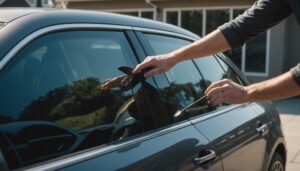Picture a chilly morning where your car refuses to start, leaving you stranded with a dead battery. Jump-starting your vehicle can be a straightforward solution if you follow the correct steps. Understanding the proper techniques and safety precautions is essential to avoid damage or injury. Let’s explore how you can efficiently bring your car back to life and the common pitfalls to steer clear of in the process.
Key Takeaways
- Ensure both vehicles are off, parked properly, and the parking brake is engaged before starting the jump process.
- Inspect jumper cables for any signs of damage or corrosion to prevent accidents while connecting.
- Connect the red cable to the dead battery first, followed by the live battery, then connect the black cable.
- Start the working vehicle and let it run for a few minutes before attempting to start the dead vehicle.
- After successfully jump-starting, check battery health regularly and maintain terminals to prevent future issues.
Understanding Car Batteries

When you’re dealing with a dead car battery, it’s essential to understand its components and function. A typical car battery consists of lead-acid cells, with six cells stacked together, each generating about 2.1 volts. The battery stores chemical energy and converts it to electrical energy through a chemical reaction when you start your vehicle.
The positive terminal connects to the vehicle’s electrical system, while the negative terminal grounds the battery. Essential components include the electrolyte solution, made from sulfuric acid and water, allowing the chemical reaction to occur.
Furthermore, batteries have a specific capacity measured in amp-hours (Ah), which indicates how much current the battery can supply over time. Factors such as temperature, age, and usage conditions impact battery life and performance. Understanding these aspects helps you identify potential issues and decide when it’s time for replacement or jump-starting.
Necessary Tools for Jump-Starting

To jump-start a car successfully, you need at least four essential tools: jumper cables, a working vehicle with a charged battery, safety goggles, and gloves. Each tool plays a vital role in guaranteeing the process goes smoothly and safely.
To jump-start your car safely, gather jumper cables, a working vehicle, safety goggles, and gloves.
Here’s what you’ll need:
- Jumper cables: The lifeline that connects your dead battery to a live one.
- Working vehicle: A reliable battery source can make all the difference.
- Safety goggles: Protect your eyes from potential battery acid or sparks.
- Gloves: Keep your hands safe while handling jumper cables and batteries.
- Emergency kit: Be prepared for any unforeseen complications during the jump.
Having these tools at your disposal guarantees you’re ready for the task ahead, minimizing stress and maximizing efficiency when you need it most. Make certain you gather everything before you begin!
Safety Precautions Before You Start

Before starting the jump-start process, it is crucial to observe a few key safety precautions. First, verify both vehicles are turned off and in park or neutral with the parking brake engaged. This prevents any accidental movement during the jump. Next, inspect the jumper cables for fraying or damage; using defective cables can lead to short circuits or electrical fires.
Position the vehicles so the batteries are within reach of the cables without them touching each other, minimizing the risk of a spark. Wear safety goggles to protect your eyes from any potential battery acid or sparks. If you have any metal jewelry, like rings or bracelets, remove them to avoid accidental contact with battery terminals. Finally, consult your vehicle’s manual for specific instructions or warnings related to jump-starting your model, as different vehicles may have unique requirements. Following these precautions will help guarantee a safe and efficient jump-start.
Step-by-Step Process to Jump-Start a Car
Jump-starting a car involves a straightforward process that can restore power to a dead battery and get you back on the road. Follow these steps carefully:
- Identify a working vehicle: Verify the donor car is compatible.
- Gather your jumper cables: Check for frayed wires or corrosion.
- Connect the cables: Attach red to the dead battery first, then the donor battery. Next, connect black to the donor battery and the other end to a grounded metal part on the dead car.
- Start the donor car: Let it run for a few minutes to charge the dead battery.
- Try starting your car: If it doesn’t start immediately, wait a few more moments and try again.
Common Mistakes to Avoid
While jump-starting a car is a relatively simple task, several common mistakes can lead to complications or even hazardous situations. One common error is connecting the jumper cables incorrectly; always verify you connect the positive terminals first, followed by the negative. Failing to do so can cause sparks or damage electrical systems. Another mistake is not using quality cables; flimsy or damaged cables can increase resistance, defeating the purpose of the jump.
Additionally, don’t ignore safety precautions—wear protective eyewear and avoid leaning over batteries to prevent acid splashes. Never attempt to jump a car with a battery that’s visibly leaking or cracked, as this can pose serious risks. Ultimately, avoid running the donor vehicle at high RPMs; excessive revving won’t speed up the charging and may harm the donor battery. By being mindful of these mistakes, you can verify a safer jump-starting experience.
Caring for Your Battery After a Jump
After successfully jump-starting your car, it’s essential to care for your battery to guarantee its longevity and peak performance. A few simple steps can make a world of difference.
Caring for your battery post-jump-start ensures longevity and peak performance, so take the time for essential maintenance.
- Keep your battery terminals clean: Corrosion can hinder performance.
- Check the charging system: Make sure your alternator is functioning properly.
- Monitor fluid levels: For lead-acid batteries, maintain the electrolyte level.
- Avoid short trips: They can prevent the battery from fully charging.
- Test regularly: Use a multimeter to verify your battery remains healthy.
Taking these actions helps prevent future failures and assures you’re ready to drive when you need to. Remember, your battery is an investment in your vehicle’s reliability, and treating it right will save you headaches down the road.
When to Seek Professional Help
Caring for your battery is important, but there are times when it’s wise to seek help from a professional. If your car struggles to start even after a jump, you may have deeper issues, such as a failing battery or an electrical system malfunction. Don’t ignore persistent warning lights on the dashboard, as they could indicate battery drain or alternator failure.
If you notice corrosion around the battery terminals or hear strange noises when you attempt to start your vehicle, consult a mechanic. Additionally, if you’ve recently replaced the battery and continue experiencing problems, professional diagnostics can uncover underlying issues.
Avoid risking your safety or causing further damage by troubleshooting complex electrical systems on your own. While jump-starting is a useful skill, knowing when to hand over the task to a professional can save you time, money, and frustration in the long run.
Frequently Asked Questions
Can I Jump-Start My Car in Freezing Temperatures?
Yes, you can jump-start your car in freezing temperatures, but you should take precautions. Cold weather can reduce battery performance considerably, so check your battery’s charge before attempting a jump. Make sure your jumper cables are in good condition and follow the proper connection process. Keep the receiving vehicle running for a few minutes after the jump to confirm your battery gets enough charge. Always prioritize safety to avoid accidents when working in cold conditions.
Will Jump-Starting Damage My Car’s Electronics?
Jump-starting your car is like sending a lifeline to a sinking ship. When done properly, it shouldn’t damage your car’s electronics. However, if you make mistakes—like connecting the cables incorrectly—you risk frying fuses or damaging sensitive components. Always use a surge protector or guarantee both cars are off before connecting. So, pay attention to the details, and your electronics should remain unharmed while you revive your engine.
How Long Should I Drive After a Jump-Start?
After a jump-start, you should drive for at least 30 minutes. This allows your alternator to recharge your battery properly. If possible, avoid short trips during this time. The engine needs to run long enough to replenish the energy used during the jump. If you notice any issues, consider getting your battery tested or inspected to confirm it’s functioning correctly and won’t leave you stranded again.
Can I Use a Portable Jump Starter Instead?
Absolutely, you can use a portable jump starter! It’s like having a superhero in your trunk, ready to save the day. These compact devices pack a punch, delivering power directly to your battery without needing another vehicle. Just make sure it’s fully charged before you attempt a jump. Follow the instructions carefully, and you’ll breathe new life into your vehicle in no time. It’s a reliable backup when traditional methods aren’t available.
What if My Headlights Turn on but the Car Won’t Start?
If your headlights turn on but the car won’t start, it’s likely not a battery issue. Check for a blown fuse, as it could prevent the starter from engaging. Also, listen for any clicking sounds when you try to start the engine; a dead starter or faulty ignition switch might be the culprit. Make sure the transmission is in ‘Park’ or ‘Neutral,’ and try again. If problems persist, consider consulting a mechanic for further diagnosis.













